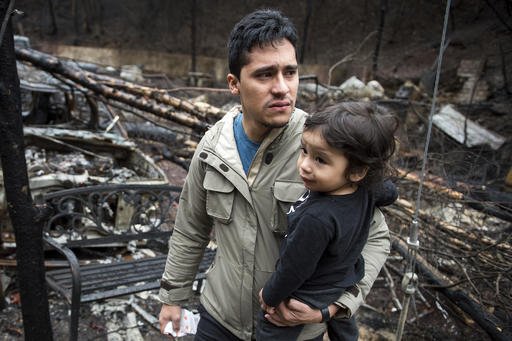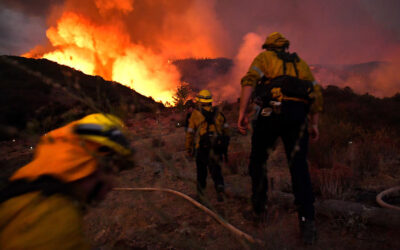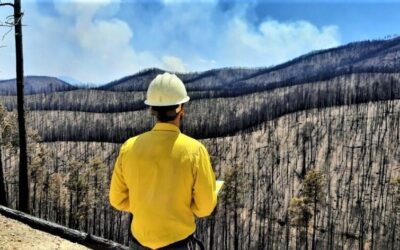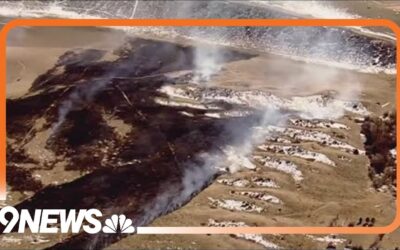Citywide evacuation broadcast did not go out to mobile devices

Allan Rivera holds onto his son Nathan Rivera, 23 months old, as he looks at the remains of their home for the first time Monday, Dec. 5, 2016, in Gatlinburg, Tenn. The family evacuated from their rental cabin before it was completely destroyed by a wildfire. A week ago on Monday, hurricane-force winds whipped up fires that killed over a dozen people and damaged or destroyed over a 1,000 buildings in the Great Smoky Mountains tourist region. (Andrew Nelles/The Tennessean via AP)
HAYES HICKMAN, Knoxville News-Sentinel
Local, state and federal officials confirmed that the order to evacuate Gatlinburg amid Monday night’s deadly firestorm was not sent to mobile devices in the area.
The reason for the failure, however, remains unclear.
John Mathews, director of the Sevier County Emergency Management Agency, said at a news conference Friday morning it was his understanding that an evacuation alert had been sent to mobile devices.
“If people did not receive the message we sent out, of course we are unsatisfied with it,” Mathews said in response to pointed questions.
The citywide evacuation was broadcast only on area TV and radio. And when it came – at 9:04 p.m. according to Tennessee Emergency Management Agency records – it was several hours after the flames had swept into Gatlinburg.
Mathews said he had relayed to TEMA Gatlinburg city officials’ decision to evacuate as flames began to overrun the tourism mecca. TEMA spokesman Dean Flener previously said records show the Sevier County EMA had asked the National Weather Service office in Morristown to announce the evacuation.
“I did not call National Weather Service — I called TEMA,” Mathews told the News Sentinel on Friday.
And as far as Matthews understood, he said, TEMA fulfilled the request.
A TEMA representative was among 60-some officials inside a local command post at the Gatlinburg Fire Department the night of the firestorm. Given the stress created by the fast-moving flames, though, Mathews admitted he doesn’t remember specifically to whom or how he communicated the request.
“It got so bad we had to leave the command post … we had to evacuate ourselves,” Matthews said, adding that the command staff was forced to relocate to a nearby community center.
Anthony Cavallucci, NWS-Morristown’s warning coordination manager, confirmed that his office issued an Emergency Alert System message announcing the evacuation shortly after 9 p.m. That alert was broadcast via TV, radio and weather radio through the Integrated Public Alert and Warning System, or IPAWS.
Various agencies, such as TEMA and the National Weather Service, are authorized to issue alerts through IPAWS, which can broadcast the messages on TV and radio, as well as send wireless text alerts to all mobile devices in a given area during an emergency.
But depending on the nature of the alert, different agencies have different levels of IPAWS access.
The National Weather Service, for instance, only can send wireless text alerts specific to weather-related events, such as tornado or flash flood warnings, Cavallucci said.
The NWS, however, is not equipped to send wireless alerts to mobile devices for civil emergencies, including calling for evacuations, he explained.
Cavallucci said his office had been in ongoing communication throughout Monday with the Sevier County E-911 dispatch center, relaying updated wind and weather forecasts.
“911 was acting as kind of a relay among (Sevier County) EMA, Gatlinburg Fire Department and us,” he explained Friday.
The weather service office contacted E-911 dispatch about 8:45 p.m. that night, asking if there was any message NWS could communicate to the public, and NWS officials were asked to relay the evacuation order.
“(E-911) told us they wanted the message sent and they told us what they wanted us to put in the message,” Cavallucci said. “Once that was communicated to us and typed into our system … it was sent out through the Emergency Alert System to TV, radio and weather radio.”
Who E-911 dispatchers were relaying the request from isn’t clear.
Further complicating matters, Flener said the National Weather Service alert still may have reached certain mobile devices that are equipped to receive weather alerts.
“If you were in Sevier County and you have a (newer) phone with the technology to receive those weather alerts, or an app enabled on your phone to receive National Weather Service alerts, you would have received the evacuation message — unless the cellphone tower in your area was damaged or destroyed,” the TEMA official said.
Meanwhile, TEMA was able to use its access to IPAWS to send a wireless message to mobile devices at 10:40 p.m. on behalf of the Sevier County Emergency Management Agency, but only to warn the public to stay off the mobile phones unless it was an emergency.
None of the evacuees interviewed by the News Sentinel as of Friday said they had received a text alert announcing the evacuation, although some said they were notified by police officers who went door to door.
Jeff Carter, a maintenance worker at Brookside Resort and Event Center, said he didn’t receive any notification. He went to sleep at 7 p.m. Monday, and woke at midnight to flames erupting near his apartment.
“No text alerts, not anything,” he said. “And you get Amber alerts on the phone.”
Others were critical of city officials’ timing altogether.
Deborah Morrison, who was visiting Gatlinburg from Middle Tennessee, said she called ahead to her hotel Monday and was told it still was OK to come. Shortly after she checked in, though, hotel staff told her to evacuate.
“It reminds me of ‘Jaws’ where they knew about that shark, but they didn’t tell people because of the money.” — Deborah Morrison
Gatlinburg visitor Ed Carnes received the text alert warning him to stay off his phone as he and his wife sat stranded in a line of cars blocked by a fallen tree on a winding mountain road above town, surrounded by thick smoke and flames.
Carnes, a U.S. Appeals Court judge from Montgomery, Ala., knew about the wildfire burning nearby in the Chimney Tops area of the Great Smoky Mountains National Park, he said. And he only learned about a voluntary evacuation urged for people in the Mynatt Park area across town while watching a TV newscast earlier that night.
But he said he never got word of the mandatory evacuation order issued for Gatlinburg before his wife opened the drapes of their condo at Highland Condominium Rentals and screamed.
“There was a wall of fire outside the condominium,” Carnes said.
“Tennessee obviously has a system to send an alert to me – and I’m from out of state. … No criticism of the folks up there, but in the future, if they’ve got the technology they need to put the alerts, voluntary or mandatory, on the (wireless) alert system.”
Flener said a wireless text wasn’t the best means of announcing the evacuation anyway, due to the constraints of IPAWS, which limits the messages to 90 characters.
“You cannot just tell them (to evacuate.) You have to tell them what to do,” Flener said. “People will panic more and you will get people in dangerous situations because you have not told them more.
The broadcast evacuation alert that was sent specified, “The city of Gatlinburg and nearby communities are being evacuated immediately. Nobody is allowed into the city of Gatlinburg at the time. If you are currently in Gatlinburg and are able to evacuate, evacuate immediately and follow any instructions from emergency officials. If you are not instructed to evacuate, please stay off the roads.”
Carnes said he and several others sheltered in their vehicles along Campbell Lead Road until about 7:30 a.m. Tuesday when emergency crews cleared the downed trees.
He credited their survival to rain that fell during the night. The Highland Condominiums, owned by Gatlinburg Mayor Mike Werner, were among more than 1,000 structures in Sevier County destroyed by the fire.
The wildfire, which killed at least 13 people, has been described by emergency officials as a “perfect storm” that grew exponentially in a rare mix of low humidity, drought conditions and erratic winds that suddenly doubled in speed to produce hurricane-force gusts up to 87 mph.
The blaze initially was reported as a 3-acre fire near the summit of the Chimney Tops on Nov. 23.
By midday Monday, Great Smoky Mountains National Park spokeswoman Dana Soehn said the fire had grown to approximately 500 acres, crossing Newfound Gap Road into the Twin Creek area on the flanks of Mount LeConte.
The flames had yet to pose a danger to any park structures or areas outside the park boundaries as federal, state and local firefighters began converging on the area. Soehn noted that wind gusts up to 85 mph were possible throughout the rest of the day.
“We sent out an alert to all of our local communities, particularly the Gatlinburg community, so they’re well aware of any potential threats that could come to structures and facilities on the park boundary,” Soehn said during a Monday news briefing on the lawn outside park headquarters.
By Monday afternoon, the city was recommending people leave the Mynatt Park area, according to TEMA logs. Around 5 p.m., city officials issued a news release assuring that no structures had caught fire within Gatlinburg.
Then, within the hour, the winds picked up tremendously, blowing flames and embers into town and bringing down power lines, which in turn ignited more spot fires.
“We went from nothing to over 20-plus structure fires in a matter of minutes, and that grew and that grew and that grew,” Gatlinburg Fire Chief Greg Miller said during a Thursday morning news conference.
Great Smoky Mountains National Park Superintendent Cassius Cash said park personnel had been working with city officials
“I don’t have the jurisdiction to evacuate a town,” Cash said during a Friday news conference. “We work collectively and that’s exactly what we did on Monday, working with the city manager, myself, the fire chief, saying, ‘OK, this is within a certain proximity; it is prudent for us now to start thinking about what would be … ”
Cash was interrupted by a reporter during the news conference, which was then cut short by Sevier County Mayor Larry Waters.
Waters said a full evaluation of the decision-making process would be made in due time.
“What we’re getting into is folks who don’t know this area and are Monday morning quarterbacking,” Waters said. “We’re not going to get into Monday morning quarterbacking right now.”
Patrol officers quickly were told to spread the evacuation order door to door.
“It was so quick that when it started it was bam, bam, bam,” Gatlinburg Police Chief Randy Brackins said. “It started with boots on the ground.”
Brandi Lamb, who was living with her husband at the Rainbow Motel on East Parkway, said a police officer drove by warning people to leave on the loudspeaker of his patrol cruiser.
The city of Gatlinburg’s Twitter feed announced mandatory evacuations for the Ski Mountain, Savage Gardens, East Foothills Road, Turkey and Davenport areas at 8:17 p.m. Another tweet was posted at 9:12 p.m. adding downtown Gatlinburg and areas along the Spur toward Pigeon Forge to the list.
Megan Boehnke, Gerald Witt, Adam Tamburin and Tyler Whetstone contributed to this report.
Copyright © 2016 LexisNexis, a division of Reed Elsevier Inc. All Rights Reserved.




